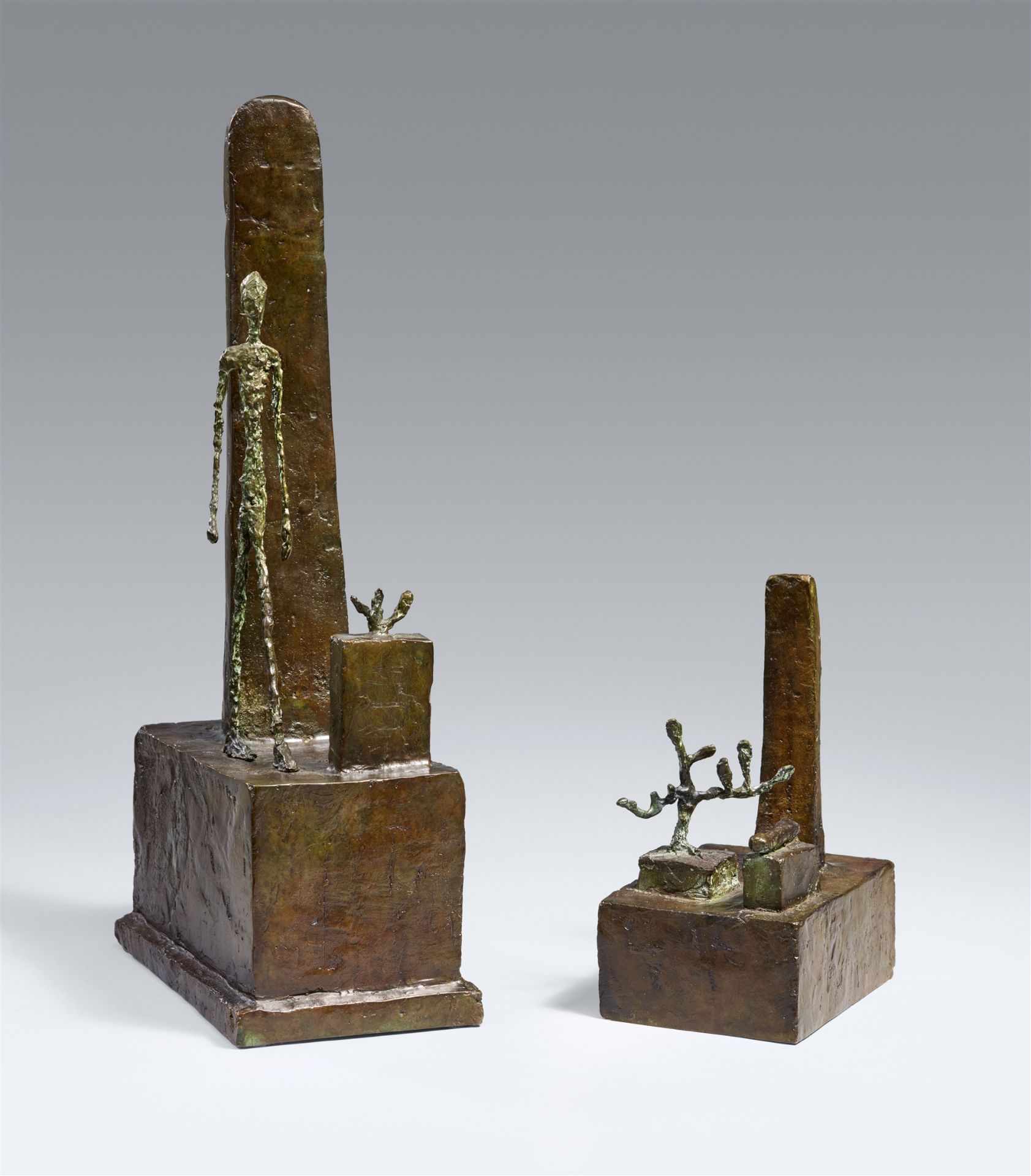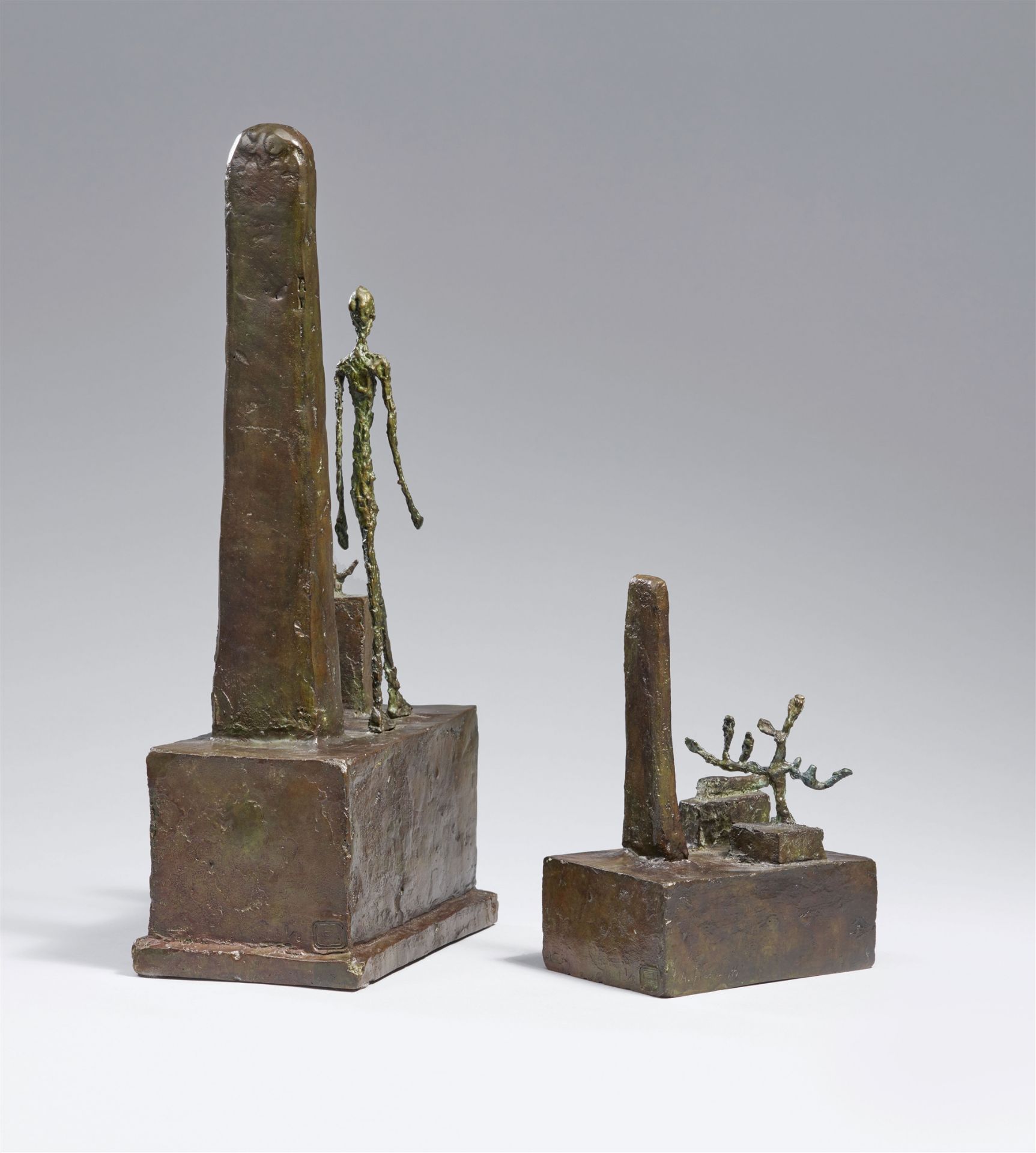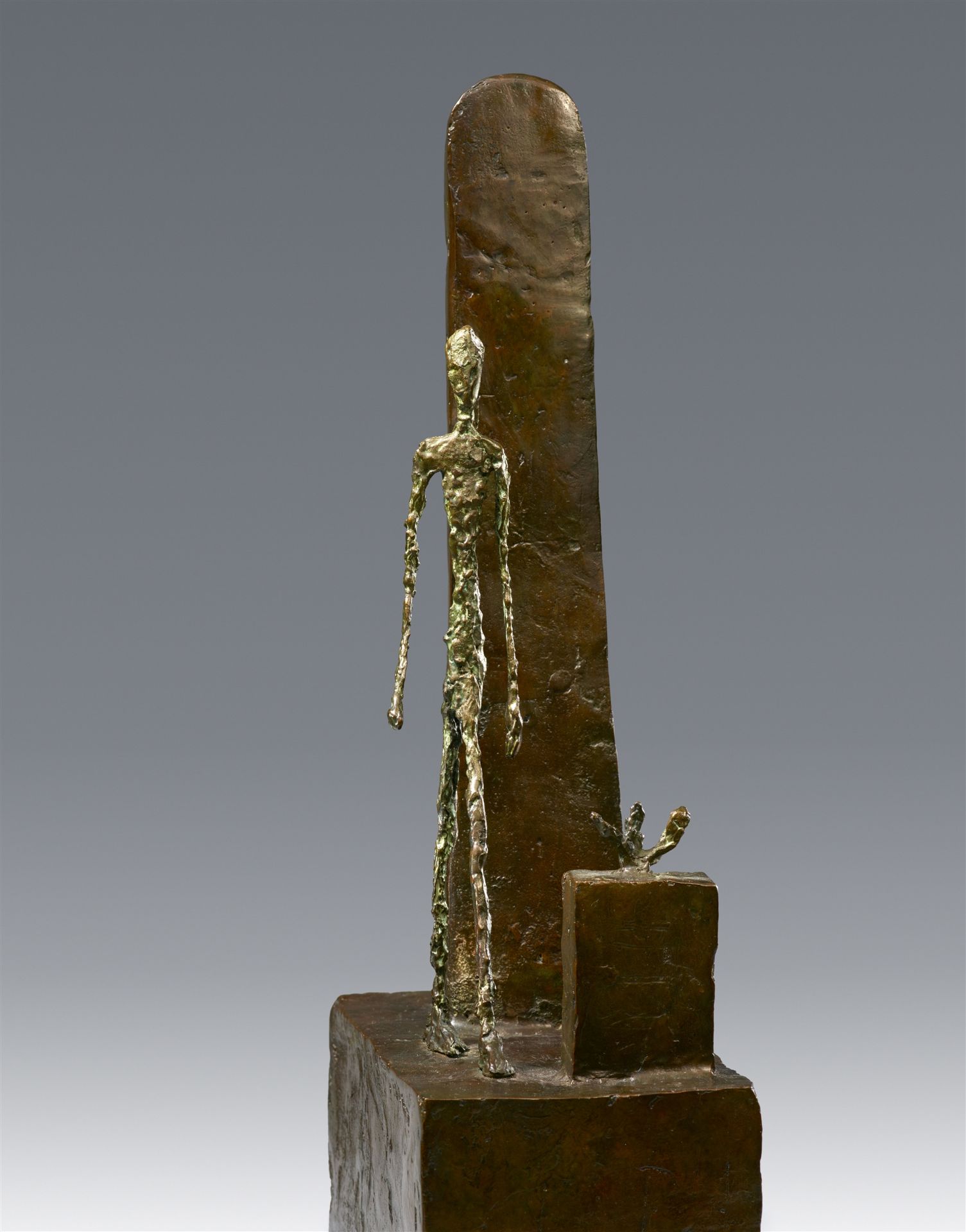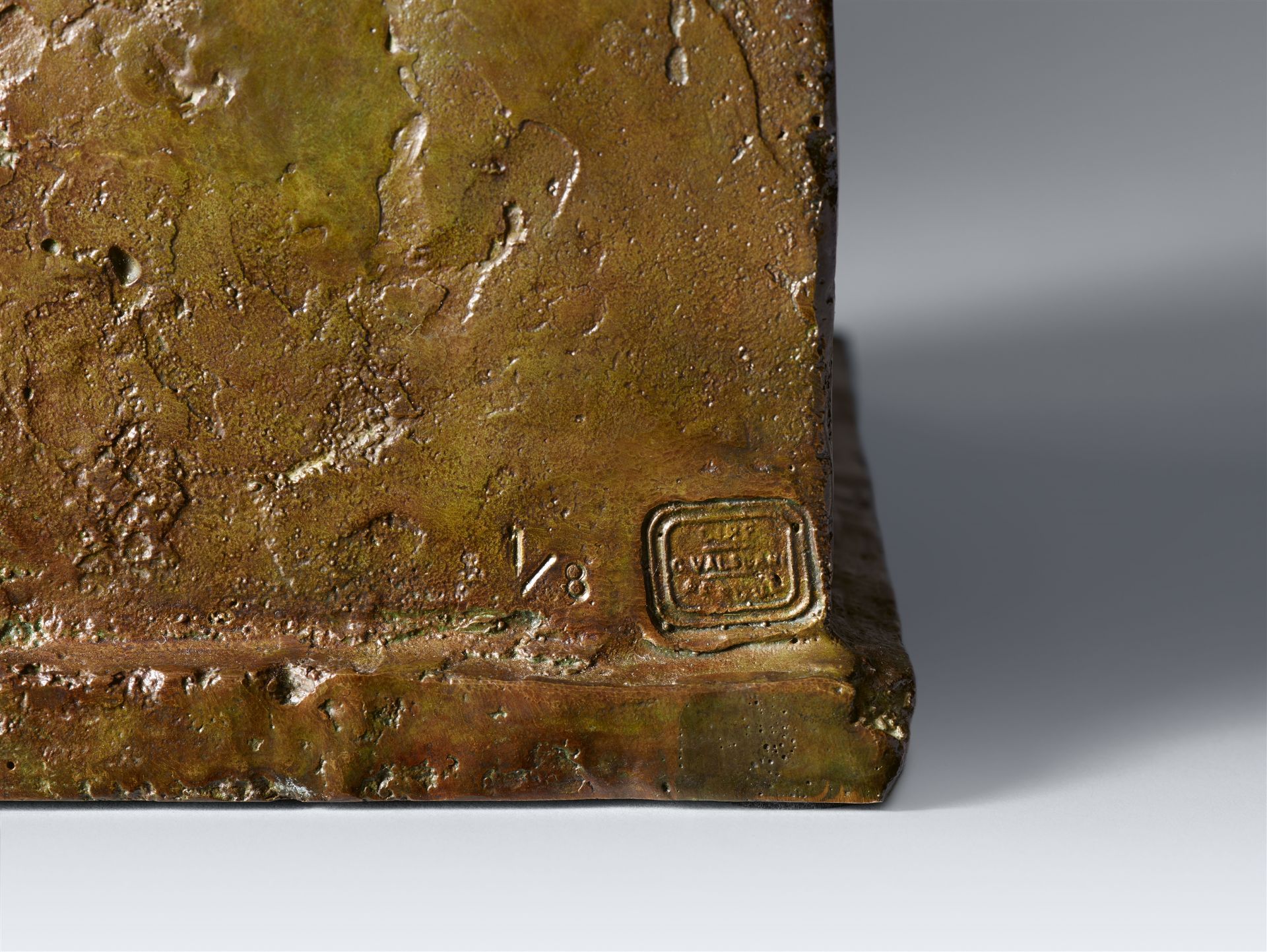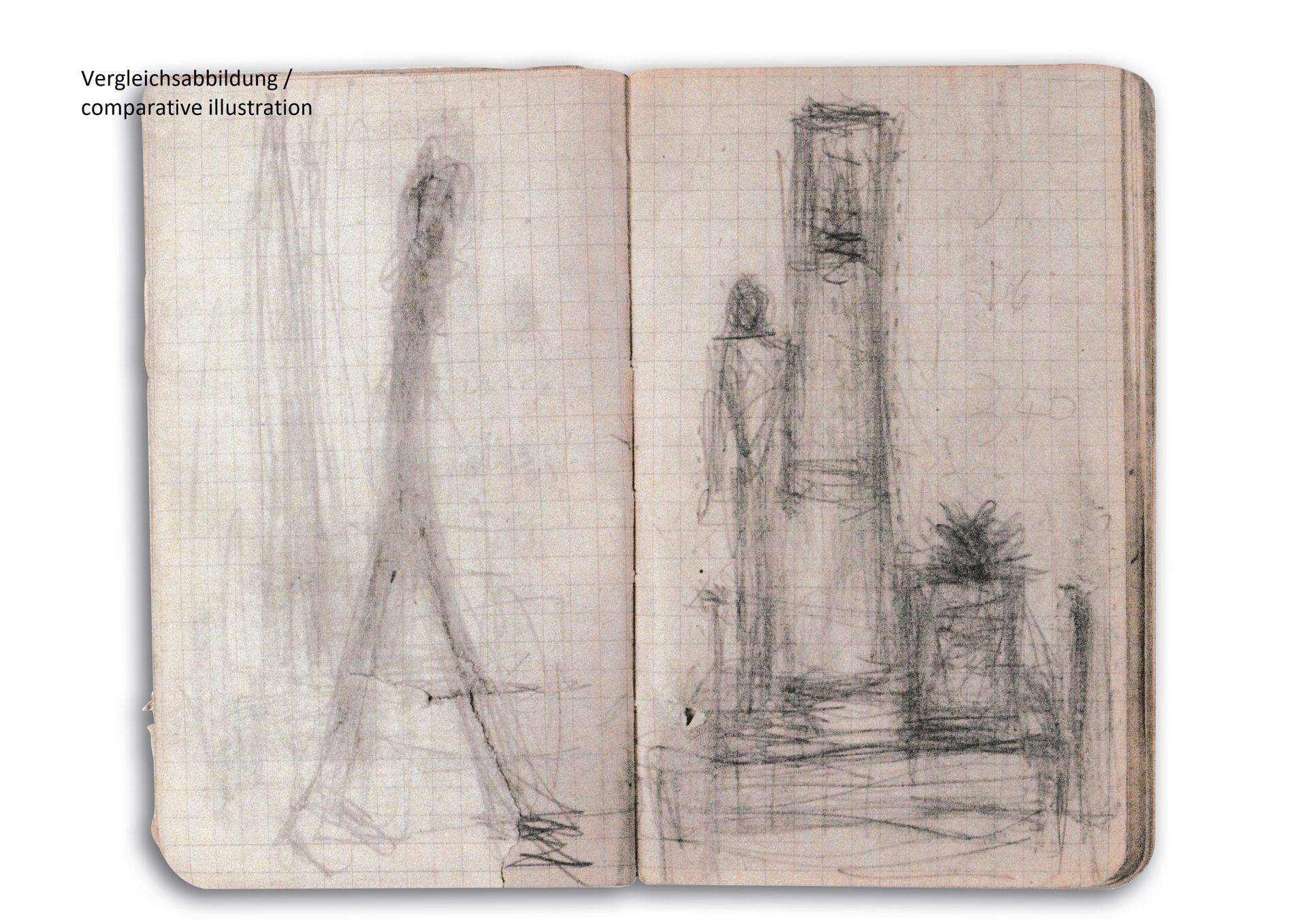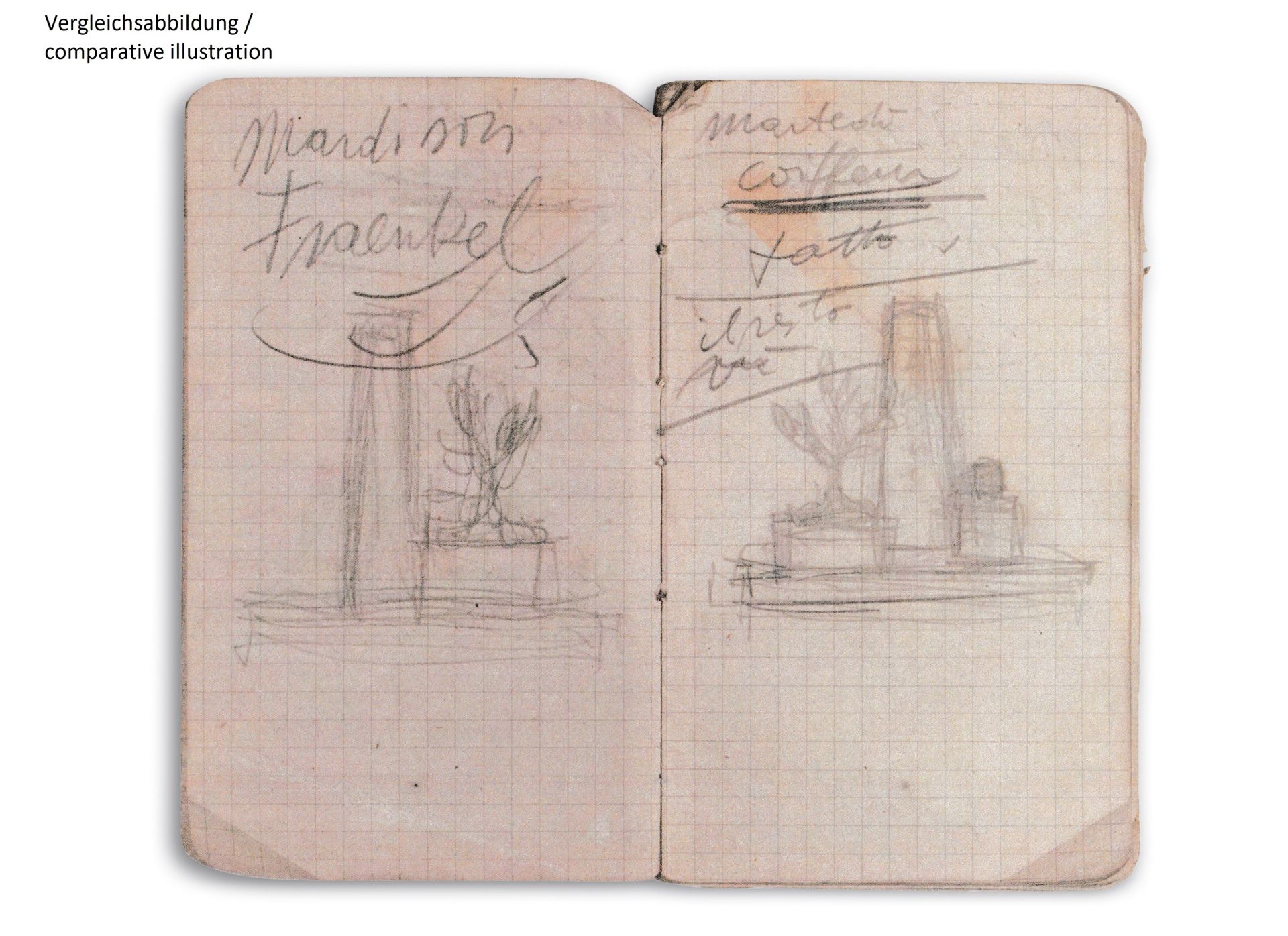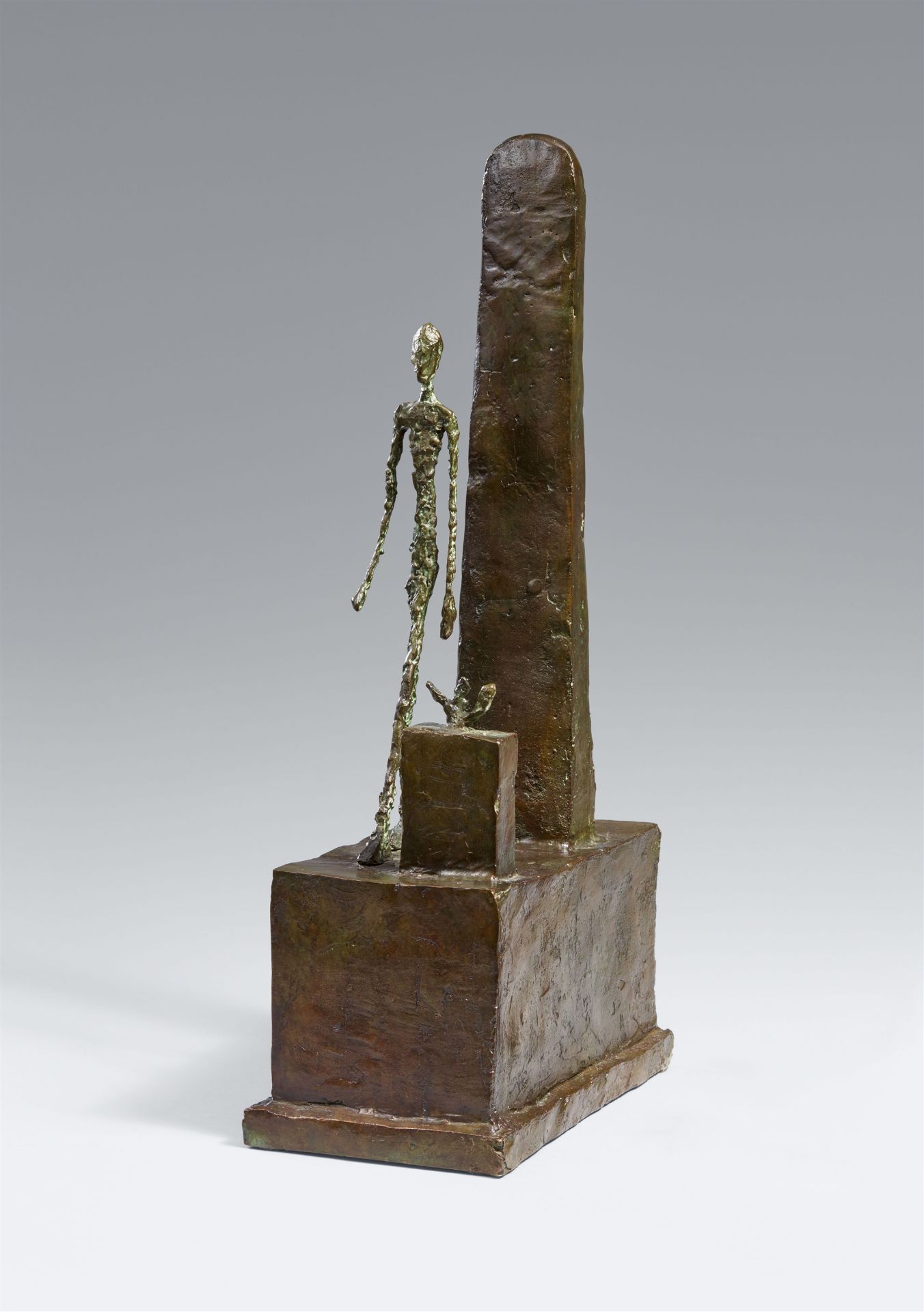38
Alberto Giacometti, Projet pour un monument pour Gabriel Péri. Projet pour une place
Zwei Bronzeplastiken. 39,2 x 10,9 x 18,6 cm und 18,5 x 9,2 x 12,7 cm. Jeweils auf der linken Seitenfläche des Sockels signiert 'A. Giacometti' sowie jeweils auf der rückseitigen Seitenfläche nummeriert und mit dem Gießerstempel "C.VALSUANI CIRE PERDUE" versehen. Jeweils Exemplar 1/8. Gegossen 1993/1994 in einer Auflage von 8 Exemplaren. - Mit schöner, grünlich-brauner Patina. - In sehr guter Erhaltung.
Alberto Giacometti Database (AGD) 3901 und 4060
Jeweils mit einer Foto-Expertise von Hubert Lacroix, Catherine Grenier und Christian Klemm, Comité Giacometti, Paris, vom März bzw. November 2018.
Aktuell setzt sich das Comité Giacometti aus folgenden Personen zusammen: Catherine Grenier, Hubert Lacroix und Casimiro Di Crescenzo.
Provenienz
Aus dem Freundeskreis des Künstlers; Privatsammlung
Ausstellungen
Heilbronn/Künzelsau 1996 (Städtische Museen/Museum Würth), Plätze und Platzzeichen: der Platz - ein Thema der Kleinplastik seit Giacometti, Kat. Nr. 51 und 52; Frankfurt am Main 1998/1999 (Schirn Kunsthalle), Alberto Giacometti. Werke und Schriften, Kat. Nr. 18 und 20, mit Abb. S. 43 und 45; Mailand/Mannheim 2000 (Fondazione Antonio Mazzotta/Städtische Kunsthalle), I Giacometti. La valle, il mondo/Die Familie Giacometti. Das Tal, die Welt, mit Abb. S. 100
Literatur
Casimiro Di Crescenzo, Giacometti - Künstler und Revolutionär, in: Ausst. Kat. Alberto Giacometti, Kunsthalle Wien/Edinburgh 1996, Stuttgart 1996, S. 48-50, vgl. Kat. Nr. 117-119; Casimiro Di Crescenzo, Giacometti, Artist and Revolutionary, in: Ausst. Kat. Alberto Giacometti, Ravenna, Loggetta Lombardesca, 10.10.2004 - 20.2.2005, Mailand 2004, S. 55 ff.
Der Denkmalsentwurf „Projet pour un monument pour Gabriel Péri“ ist ein bedeutender Meilenstein im Oeuvre Alberto Giacomettis. Erstmals führt er hier das bedeutende Motiv des schreitenden Mannes aus, das sein weiteres Schaffen maßgeblich dominiert und letztendlich in seinem berühmtesten Werk kulminiert, dem lebensgroßen „L’homme qui marche“ von 1960.
Unmittelbar nach dem Ende des II. Weltkrieges wurden in Frankreich vielfach bildnerische Projekte angeregt, um die Opfer und Helden der Résistance zu ehren. Auch Alberto Giacometti beteiligte sich, wohl auf Anregung von Louis Aragon, mehrfach an der Konzeption solcher Denkmäler. 1946 schrieb die Zeitung "L'Humanité" einen Wettbewerb zu Ehren des Journalisten und Abgeordneten der Kommunistischen Partei Gabriel Péri (1902-1941) aus, der von den deutschen Besatzern nach einer öffentlichen Rede in der Nationalversammlung in Paris verhaftet und umgebracht worden war. Casimiro Di Crescenzo, Giacometti-Forscher und Mitglied des Comité Giacometti, hat sich intensiv mit der Geschichte dieses Denkmalentwurfs auseinandergesetzt: „Man plante für Gabriel Péri ein Denkmal, das vor dem Bahnhof von Saint Lazare (jetzt Place Gabriel Péri) platziert werden sollte. Die Wahl war auf diesen Ort gefallen, weil sich dort die Endstation der Zugverbindung nach Argenteuil befand, jener Stadt, die Gabriel Péri als Abgeordneter vertreten hatte. Dieser Wettbewerb sollte nie entschieden werden, weil die Kommunistische Partei 1947 aus der Regierung schied und damit auch die Idee des Denkmals fallengelassen werden musste.“ (Casimiro Di Crescenzo, Giacometti - Künstler und Revolutionär, in: Ausst. Kat. Alberto Giacometti, Kunsthalle Wien/Edinburgh 1996, Stuttgart 1996, S. 49; ders., Giacometti, Artist and Revolutionary, in: Ausst. Kat. Alberto Giacometti, Ravenna, Loggetta Lombardesca, 10.10.2004 - 20.2.2005, Mailand 2004, S. 56).
Giacometti entwarf das in monumentalen Größenmaßstäben konzipierte Mahnmal teils in Zusammenarbeit mit dem amerikanischen Architekten Paul Nelson, der den Sockel gestalten sollte. Nachdem die Realisation verworfen worden war, verblieb die ursprüngliche Konzeption des „Projet pour un monument pour Gabriel Péri“, die Alberto Giacometti noch ohne die Beteiligung Nelsons erstellt hatte, als Gipsentwurf in seinem Atelier. Er ging später an seinen Bruder Diego über, ebenso wie das gleichfalls in diesem Zusammenhang entstandene Modell „Projet pour une place“. 1993/94 wurden von diesen beiden bedeutenden Gipsen Bronzegüsse in einer Auflage von je 8 Exemplaren angefertigt.
„Projet pour un monument pour Gabriel Péri“ markiert eine Zäsur im künstlerischen Werk Alberto Giacomettis, denn erstmals realisiert er hier die Darstellung eines schreitenden Mannes. Die Plastik kombiniert die archaische Form einer aufrechten Stele mit der für das Oeuvre Giacomettis so charakteristischen menschlichen Figur. Die schmale, stark gelängte Silhouette des schreitenden Mannes zeigt die bedeutende Wandlung zu seinem reifen Stil, nachdem die früheren surrealistischen Abstraktionen bereits Mitte der 1930er Jahre von realistischen Porträtdarstellungen abgelöst worden waren.
„Hatte der Künstler für das Grabmal des Vaters 1934 und für dasjenige von Gerda Taro 1937-1938 eine der frühchristlichen und ägyptischen Kunst entlehnte Symbolsprache benutzt, um die Vorstellung der Unsterblichkeit zum Ausdruck zu bringen, so begann er in ‚Projet pour un monument pour Gabriel Péri‘ eine persönlichere Symbolik zu entwickeln. Die Komposition besteht aus einer schreitenden männlichen Figur neben einer Stele […]. Das Flammenmotiv ist eine Anspielung auf die Flamme der Erinnerung auf dem Grab des Unbekannten Soldaten unter dem Arc de Triomphe. Erstmals gelangt in Giacomettis plastischer Arbeit die Figur des schreitenden Mannes zur Ausführung, sicherlich mit Bezug auf die Kunst des alten Ägyptens, wo dieses Motiv den Zugang in das Totenreich mit dem ewigen Leben in Einklang bringt. Bedenkt man, dass die Plastik als Denkmal konzipiert war, kann das Auftauchen der schreitenden männlichen Figur nicht über Wahrnehmungstheorien erklärt werden. Einsichtig erscheint es, wenn man […] eine mythische Dimension im Werk des Künstlers erkennt. Vor der Entstehung dieser Plastik standen weibliche schreitende Figuren als Metapher für die Ganzheit des Lebens: beispielsweise in der Zeichnung ‚Danseuse des corde‘, 1943, oder in der Gipsplastik ‚La nuit‘, 1946-1947 - eine schreitende weibliche Figur auf einer sarkophagähnlichen Basis, die als Denkmal für den französischen Widerstand konzipiert war. Später, 1950, mit ‚Figurine dans une boîte entre deux maisons‘ und ‚Le chariot‘, das als Monument für einen öffentlichen Pariser Platz gedacht war, wird die Frau nur noch unbewegt stehend dargestellt. Dagegen vermehren sich die Plastiken von schreitenden Männern, wie ‚Homme qui marche sous la pluie‘, 1948, und ‚Trois hommes qui marchent‘, 1948. Wenn die Arbeiten für die besagten Wettbewerbe aus je unterschiedlichen Gründen auch nie über das Projektstadium hinausgelangten, kamen sie jedoch Giacomettis Kunstwollen entgegen, Kompositionen mit Figuren zur Ausführung zu bringen.“ (Di Crescenzo, a.a.O.).
„Projet pour une place“ steht in direktem Entstehungskontext zu dem Denkmal von Gabriel Péri, wie Fotoaufnahmen aus Diego Giacomettis Atelier, vor allem aber Entwurfsskizzen aus dem Notizbuch Alberto Giacomettis aus dem Jahr 1946 belegen (s. Vergleichsabb.)
Von besonderem Interesse ist hier der Bezug zu einer gleichnamigen surrealistischen Arbeit von 1932. Dieser frühe Entwurf, der auf einer rechteckigen Plinthe verschiedene abstrakte Formen verselbständigt hat und räumlich zueinander arrangiert, zeigt schon zentral die senkrecht ragende und oben abgerundete Stele, die in dem vorliegenden Entwurf von 1946 wieder als bedeutungsvolles Mahnmal aufgerichtet wird.
„Der Platz wäre demnach mit der späteren Place de Gabriel Pétri vor dem Bahnhof Saint Lazare identisch. Das Denkmal symbolisiert Leben und Tod in Form eines wachsenden und eines gefällten Baumes. […] Entstehungsgeschichtlich liegt ‚Projet pour une place‘ zwei bis drei Jahre vor ähnlichen Plastiken wie ‚Place‘ und ‚Trois hommes qui marchent‘.“ (Di Crescenzo, a.a.O.)
Two bronze sculptures. 39.2 x 10.9 x 18.6 cm and 18.5 x 9.2 x 12.7 cm. Each signed 'A. Giacometti' on the left side of the base as well as numbered and with foundry mark "C.VALSUANI CIRE PERDUE" on the back side. Each numbered 1/8. Cast 1993/1994 in an edition of 8. - Fine greenish-brown patina. - In very good condition.
Alberto Giacometti Database (AGD) 3901 and 4060
Each with a photo-certificate from Hubert Lacroix, Catherine Grenier and Christian Klemm, Comité Giacometti, Paris, dated March resp. November 2018.
Currently, the Comité Giacometti consists of the following persons: Catherine Grenier, Hubert Lacroix and Casimiro Di Crescenzo.
Provenance
From the circle of the artist's friends; Private collection
Exhibitions
Heilbronn/Künzelsau 1996 (Städtische Museen/Museum Würth), Plätze und Platzzeichen: der Platz - ein Thema der Kleinplastik seit Giacometti, cat. no. 51 and 52; Frankfurt am Main 1998/1999 (Schirn Kunsthalle), Alberto Giacometti. Werke und Schriften, cat. no. 18 and 20, with ill. p. 43 and 45; Milan/Mannheim 2000 (Fondazione Antonio Mazzotta/Städtische Kunsthalle), I Giacometti. La valle, il mondo/Die Familie Giacometti. Das Tal, die Welt, with ill. p. 100
Literature
Casimiro Di Crescenzo, Giacometti - Künstler und Revolutionär, in: Exh. cat. Alberto Giacometti, Kunsthalle Wien/Edinburgh 1996, Stuttgart 1996, p. 48-50, cf. cat. no. 117-119; Casimiro Di Crescenzo, Giacometti, Artist and Revolutionary, in: Exh. cat. Alberto Giacometti, Ravenna, Loggetta Lombardesca, 10 Oct. 2004 - 20 Feb. 2005, Milan 2004, p. 55 ff.
The monument design “Projet pour un monument pour Gabriel Péri” represents an important milestone in Alberto Giacometti’s oeuvre. It was the first time he realised the important motif of the walking man, which would decisively dominate the rest of his oeuvre and ultimately culminate in his most famous work, the life-size “L’homme qui marche” of 1960.
Directly after the end of World War II, numerous artistic projects were initiated in France to honour the victims and heroes of the Résistance. Alberto Giacometti also participated by developing concepts for a number of these monuments, presumably at the suggestion of Louis Aragon. In 1946 the newspaper “L’Humanité” announced a competition to honour the journalist and Communist MP Gabriel Péri (1902–1941), who had been arrested and killed by the occupying Germans after a public speech in the national assembly. Casimiro Di Crescenzo, Giacometti researcher and member of the Comité Giacometti, has intensively studied the history of this monument design: “The plan was to build a monument to Gabriel Péri that would be installed in front of the station of Saint-Lazare (today Place Gabriel Péri). The location was chosen because this station was the terminus for the trains that served Argenteuil, the town for which Gabriel Péri was deputy. The competition was never concluded since the French Communist Party was ousted from the government in 1947 and the idea of the monument consequently abandoned” (Casimiro Di Crescenzo, Giacometti - Künstler und Revolutionär, in: exh. cat. Alberto Giacometti, Kunsthalle Wien/Edinburgh 1996, Stuttgart 1996, p. 49; idem, Giacometti, Artist and Revolutionary, in: Exh. cat. Alberto Giacometti, Ravenna, Loggetta Lombardesca, 10.10.2004 - 20.2.2005, Milan 2004, p. 56).
Giacometti designed the monumentally dimensioned memorial concept partially in cooperation with the American architect Paul Nelson, who was to design its base. After its realisation had been abandoned, the original concept for the “Projet pour un monument pour Gabriel Péri”, which Alberto Giacometti had still produced without the involvement of Nelson, remained in his studio as a plaster model. It later went to his brother Diego – as did the model “Projet pour une place”, which was also created in this context. In 1993/94 bronze versions were made of these two important plaster pieces, each in an edition of eight casts.
“Projet pour un monument pour Gabriel Péri” marks a decisive point in Alberto Giacometti’s oeuvre, because it was the first time he realised a depiction of a man walking. The sculpture combines the archaic form of an upright stele with the human figure so characteristic of Giacometti’s oeuvre. The slender, thoroughly elongated silhouette of the walking man presents the important shift to his mature style – after his earlier surrealist abstractions had already been replaced by realistic portrait images in the mid 1930s.
“While the artist had used a symbolic idiom borrowed from Early Christian and Egyptian art for the tombstone of his father in 1934 and that of Gerda Taro in 1937–1938 in order to give expression to the idea of immortality, he began to develop a more personal symbolism in ‘Projet pour un monument pour Gabriel Péri’. The composition consists of a walking male figure next to a stele […]. The flame motif is an allusion to the memorial flame at the Tomb of the Unknown Soldier beneath the Arc de Triomphe. For the first time in his post-war sculpture, Giacometti introduced the figure of the man walking, but noiw in relation to ancient Egyptian art in which this theme links entry into the kingdom of the dead with eternal survival. Considering that the sculpture was conceived as a monument, the emergence of the walking male figure cannot be explained by way of theories of perception. It seems persuasive, if […] a mythological dimension is recognised in the artist’s work. Prior to the creation of this sculpture, female walking figures had served as a metaphor for the totality of life, for example, in the drawing ‘Danseuse des corde’, 1943, or the plaster sculpture ‘La nuit’, 1946–1947 – a walking female figure on a sarcophagus-like base, which was conceived as a monument for the French Resistance. Later, in 1950, with ‘Figurine dans une boîte entre deux maisons” and ‘Le chariot’, which was intended as a monument for a public square in Paris, women would only be depicted as standing motionlessly. By contrast, the number of sculptures of walking men increases, including ‘Homme qui marche sous la pluie’, 1948, and ‘Trois hommes qui marchent’, 1948. Even if the works for the competitions mentioned here never advanced beyond a preliminary phase – each for its own different reasons – they nonetheless corresponded to Giacometti’s artistic will to carry out compositions with figures” (Di Crescenzo, op. cit.).
The creation of “Projet pour une place” was directly connected with the Gabriel Péri monument, as is demonstrated by photographs from Diego Giacometti’s studio and, even more so, by design sketches from Alberto Giacometti’s notebook from 1946 (see comparative ill.).
The link with a surrealist work of the same name from 1932 is of particular interest here. In this early design, various abstract forms have taken on a life of their own on a rectangular plinth and are arranged in relation to one another in space while the vertical surge of the rounded stela, which is erected once again in our design from 1946 as a semantically charged monument, is centrally displayed.
“Accordingly, the square would have been identical to the future Place de Gabriel Pétri in front of the Gare Saint-Lazare. The monument symbolises life and death in the form of one growing and one felled tree. […] In terms of the history of its creation, ‘Projet pour une place’ came two to three years before similar sculptures, such as ‘Place’ and ‘Trois hommes qui marchent’” (Di Crescenzo, op. cit.).
Together, the two works stand for the seminal shift in Alberto Giacometti’s development as an artist by uniting two important key symbols, the tree and the stele, with the innovative motif of the walking man to form a highly concentrated ensemble – the essence of Giacometti’s artistic and intellectual vision in 1946.
Zwei Bronzeplastiken. 39,2 x 10,9 x 18,6 cm und 18,5 x 9,2 x 12,7 cm. Jeweils auf der linken Seitenfläche des Sockels signiert 'A. Giacometti' sowie jeweils auf der rückseitigen Seitenfläche nummeriert und mit dem Gießerstempel "C.VALSUANI CIRE PERDUE" versehen. Jeweils Exemplar 1/8. Gegossen 1993/1994 in einer Auflage von 8 Exemplaren. - Mit schöner, grünlich-brauner Patina. - In sehr guter Erhaltung.
Alberto Giacometti Database (AGD) 3901 und 4060
Jeweils mit einer Foto-Expertise von Hubert Lacroix, Catherine Grenier und Christian Klemm, Comité Giacometti, Paris, vom März bzw. November 2018.
Aktuell setzt sich das Comité Giacometti aus folgenden Personen zusammen: Catherine Grenier, Hubert Lacroix und Casimiro Di Crescenzo.
Provenienz
Aus dem Freundeskreis des Künstlers; Privatsammlung
Ausstellungen
Heilbronn/Künzelsau 1996 (Städtische Museen/Museum Würth), Plätze und Platzzeichen: der Platz - ein Thema der Kleinplastik seit Giacometti, Kat. Nr. 51 und 52; Frankfurt am Main 1998/1999 (Schirn Kunsthalle), Alberto Giacometti. Werke und Schriften, Kat. Nr. 18 und 20, mit Abb. S. 43 und 45; Mailand/Mannheim 2000 (Fondazione Antonio Mazzotta/Städtische Kunsthalle), I Giacometti. La valle, il mondo/Die Familie Giacometti. Das Tal, die Welt, mit Abb. S. 100
Literatur
Casimiro Di Crescenzo, Giacometti - Künstler und Revolutionär, in: Ausst. Kat. Alberto Giacometti, Kunsthalle Wien/Edinburgh 1996, Stuttgart 1996, S. 48-50, vgl. Kat. Nr. 117-119; Casimiro Di Crescenzo, Giacometti, Artist and Revolutionary, in: Ausst. Kat. Alberto Giacometti, Ravenna, Loggetta Lombardesca, 10.10.2004 - 20.2.2005, Mailand 2004, S. 55 ff.
Der Denkmalsentwurf „Projet pour un monument pour Gabriel Péri“ ist ein bedeutender Meilenstein im Oeuvre Alberto Giacomettis. Erstmals führt er hier das bedeutende Motiv des schreitenden Mannes aus, das sein weiteres Schaffen maßgeblich dominiert und letztendlich in seinem berühmtesten Werk kulminiert, dem lebensgroßen „L’homme qui marche“ von 1960.
Unmittelbar nach dem Ende des II. Weltkrieges wurden in Frankreich vielfach bildnerische Projekte angeregt, um die Opfer und Helden der Résistance zu ehren. Auch Alberto Giacometti beteiligte sich, wohl auf Anregung von Louis Aragon, mehrfach an der Konzeption solcher Denkmäler. 1946 schrieb die Zeitung "L'Humanité" einen Wettbewerb zu Ehren des Journalisten und Abgeordneten der Kommunistischen Partei Gabriel Péri (1902-1941) aus, der von den deutschen Besatzern nach einer öffentlichen Rede in der Nationalversammlung in Paris verhaftet und umgebracht worden war. Casimiro Di Crescenzo, Giacometti-Forscher und Mitglied des Comité Giacometti, hat sich intensiv mit der Geschichte dieses Denkmalentwurfs auseinandergesetzt: „Man plante für Gabriel Péri ein Denkmal, das vor dem Bahnhof von Saint Lazare (jetzt Place Gabriel Péri) platziert werden sollte. Die Wahl war auf diesen Ort gefallen, weil sich dort die Endstation der Zugverbindung nach Argenteuil befand, jener Stadt, die Gabriel Péri als Abgeordneter vertreten hatte. Dieser Wettbewerb sollte nie entschieden werden, weil die Kommunistische Partei 1947 aus der Regierung schied und damit auch die Idee des Denkmals fallengelassen werden musste.“ (Casimiro Di Crescenzo, Giacometti - Künstler und Revolutionär, in: Ausst. Kat. Alberto Giacometti, Kunsthalle Wien/Edinburgh 1996, Stuttgart 1996, S. 49; ders., Giacometti, Artist and Revolutionary, in: Ausst. Kat. Alberto Giacometti, Ravenna, Loggetta Lombardesca, 10.10.2004 - 20.2.2005, Mailand 2004, S. 56).
Giacometti entwarf das in monumentalen Größenmaßstäben konzipierte Mahnmal teils in Zusammenarbeit mit dem amerikanischen Architekten Paul Nelson, der den Sockel gestalten sollte. Nachdem die Realisation verworfen worden war, verblieb die ursprüngliche Konzeption des „Projet pour un monument pour Gabriel Péri“, die Alberto Giacometti noch ohne die Beteiligung Nelsons erstellt hatte, als Gipsentwurf in seinem Atelier. Er ging später an seinen Bruder Diego über, ebenso wie das gleichfalls in diesem Zusammenhang entstandene Modell „Projet pour une place“. 1993/94 wurden von diesen beiden bedeutenden Gipsen Bronzegüsse in einer Auflage von je 8 Exemplaren angefertigt.
„Projet pour un monument pour Gabriel Péri“ markiert eine Zäsur im künstlerischen Werk Alberto Giacomettis, denn erstmals realisiert er hier die Darstellung eines schreitenden Mannes. Die Plastik kombiniert die archaische Form einer aufrechten Stele mit der für das Oeuvre Giacomettis so charakteristischen menschlichen Figur. Die schmale, stark gelängte Silhouette des schreitenden Mannes zeigt die bedeutende Wandlung zu seinem reifen Stil, nachdem die früheren surrealistischen Abstraktionen bereits Mitte der 1930er Jahre von realistischen Porträtdarstellungen abgelöst worden waren.
„Hatte der Künstler für das Grabmal des Vaters 1934 und für dasjenige von Gerda Taro 1937-1938 eine der frühchristlichen und ägyptischen Kunst entlehnte Symbolsprache benutzt, um die Vorstellung der Unsterblichkeit zum Ausdruck zu bringen, so begann er in ‚Projet pour un monument pour Gabriel Péri‘ eine persönlichere Symbolik zu entwickeln. Die Komposition besteht aus einer schreitenden männlichen Figur neben einer Stele […]. Das Flammenmotiv ist eine Anspielung auf die Flamme der Erinnerung auf dem Grab des Unbekannten Soldaten unter dem Arc de Triomphe. Erstmals gelangt in Giacomettis plastischer Arbeit die Figur des schreitenden Mannes zur Ausführung, sicherlich mit Bezug auf die Kunst des alten Ägyptens, wo dieses Motiv den Zugang in das Totenreich mit dem ewigen Leben in Einklang bringt. Bedenkt man, dass die Plastik als Denkmal konzipiert war, kann das Auftauchen der schreitenden männlichen Figur nicht über Wahrnehmungstheorien erklärt werden. Einsichtig erscheint es, wenn man […] eine mythische Dimension im Werk des Künstlers erkennt. Vor der Entstehung dieser Plastik standen weibliche schreitende Figuren als Metapher für die Ganzheit des Lebens: beispielsweise in der Zeichnung ‚Danseuse des corde‘, 1943, oder in der Gipsplastik ‚La nuit‘, 1946-1947 - eine schreitende weibliche Figur auf einer sarkophagähnlichen Basis, die als Denkmal für den französischen Widerstand konzipiert war. Später, 1950, mit ‚Figurine dans une boîte entre deux maisons‘ und ‚Le chariot‘, das als Monument für einen öffentlichen Pariser Platz gedacht war, wird die Frau nur noch unbewegt stehend dargestellt. Dagegen vermehren sich die Plastiken von schreitenden Männern, wie ‚Homme qui marche sous la pluie‘, 1948, und ‚Trois hommes qui marchent‘, 1948. Wenn die Arbeiten für die besagten Wettbewerbe aus je unterschiedlichen Gründen auch nie über das Projektstadium hinausgelangten, kamen sie jedoch Giacomettis Kunstwollen entgegen, Kompositionen mit Figuren zur Ausführung zu bringen.“ (Di Crescenzo, a.a.O.).
„Projet pour une place“ steht in direktem Entstehungskontext zu dem Denkmal von Gabriel Péri, wie Fotoaufnahmen aus Diego Giacomettis Atelier, vor allem aber Entwurfsskizzen aus dem Notizbuch Alberto Giacomettis aus dem Jahr 1946 belegen (s. Vergleichsabb.)
Von besonderem Interesse ist hier der Bezug zu einer gleichnamigen surrealistischen Arbeit von 1932. Dieser frühe Entwurf, der auf einer rechteckigen Plinthe verschiedene abstrakte Formen verselbständigt hat und räumlich zueinander arrangiert, zeigt schon zentral die senkrecht ragende und oben abgerundete Stele, die in dem vorliegenden Entwurf von 1946 wieder als bedeutungsvolles Mahnmal aufgerichtet wird.
„Der Platz wäre demnach mit der späteren Place de Gabriel Pétri vor dem Bahnhof Saint Lazare identisch. Das Denkmal symbolisiert Leben und Tod in Form eines wachsenden und eines gefällten Baumes. […] Entstehungsgeschichtlich liegt ‚Projet pour une place‘ zwei bis drei Jahre vor ähnlichen Plastiken wie ‚Place‘ und ‚Trois hommes qui marchent‘.“ (Di Crescenzo, a.a.O.)
Two bronze sculptures. 39.2 x 10.9 x 18.6 cm and 18.5 x 9.2 x 12.7 cm. Each signed 'A. Giacometti' on the left side of the base as well as numbered and with foundry mark "C.VALSUANI CIRE PERDUE" on the back side. Each numbered 1/8. Cast 1993/1994 in an edition of 8. - Fine greenish-brown patina. - In very good condition.
Alberto Giacometti Database (AGD) 3901 and 4060
Each with a photo-certificate from Hubert Lacroix, Catherine Grenier and Christian Klemm, Comité Giacometti, Paris, dated March resp. November 2018.
Currently, the Comité Giacometti consists of the following persons: Catherine Grenier, Hubert Lacroix and Casimiro Di Crescenzo.
Provenance
From the circle of the artist's friends; Private collection
Exhibitions
Heilbronn/Künzelsau 1996 (Städtische Museen/Museum Würth), Plätze und Platzzeichen: der Platz - ein Thema der Kleinplastik seit Giacometti, cat. no. 51 and 52; Frankfurt am Main 1998/1999 (Schirn Kunsthalle), Alberto Giacometti. Werke und Schriften, cat. no. 18 and 20, with ill. p. 43 and 45; Milan/Mannheim 2000 (Fondazione Antonio Mazzotta/Städtische Kunsthalle), I Giacometti. La valle, il mondo/Die Familie Giacometti. Das Tal, die Welt, with ill. p. 100
Literature
Casimiro Di Crescenzo, Giacometti - Künstler und Revolutionär, in: Exh. cat. Alberto Giacometti, Kunsthalle Wien/Edinburgh 1996, Stuttgart 1996, p. 48-50, cf. cat. no. 117-119; Casimiro Di Crescenzo, Giacometti, Artist and Revolutionary, in: Exh. cat. Alberto Giacometti, Ravenna, Loggetta Lombardesca, 10 Oct. 2004 - 20 Feb. 2005, Milan 2004, p. 55 ff.
The monument design “Projet pour un monument pour Gabriel Péri” represents an important milestone in Alberto Giacometti’s oeuvre. It was the first time he realised the important motif of the walking man, which would decisively dominate the rest of his oeuvre and ultimately culminate in his most famous work, the life-size “L’homme qui marche” of 1960.
Directly after the end of World War II, numerous artistic projects were initiated in France to honour the victims and heroes of the Résistance. Alberto Giacometti also participated by developing concepts for a number of these monuments, presumably at the suggestion of Louis Aragon. In 1946 the newspaper “L’Humanité” announced a competition to honour the journalist and Communist MP Gabriel Péri (1902–1941), who had been arrested and killed by the occupying Germans after a public speech in the national assembly. Casimiro Di Crescenzo, Giacometti researcher and member of the Comité Giacometti, has intensively studied the history of this monument design: “The plan was to build a monument to Gabriel Péri that would be installed in front of the station of Saint-Lazare (today Place Gabriel Péri). The location was chosen because this station was the terminus for the trains that served Argenteuil, the town for which Gabriel Péri was deputy. The competition was never concluded since the French Communist Party was ousted from the government in 1947 and the idea of the monument consequently abandoned” (Casimiro Di Crescenzo, Giacometti - Künstler und Revolutionär, in: exh. cat. Alberto Giacometti, Kunsthalle Wien/Edinburgh 1996, Stuttgart 1996, p. 49; idem, Giacometti, Artist and Revolutionary, in: Exh. cat. Alberto Giacometti, Ravenna, Loggetta Lombardesca, 10.10.2004 - 20.2.2005, Milan 2004, p. 56).
Giacometti designed the monumentally dimensioned memorial concept partially in cooperation with the American architect Paul Nelson, who was to design its base. After its realisation had been abandoned, the original concept for the “Projet pour un monument pour Gabriel Péri”, which Alberto Giacometti had still produced without the involvement of Nelson, remained in his studio as a plaster model. It later went to his brother Diego – as did the model “Projet pour une place”, which was also created in this context. In 1993/94 bronze versions were made of these two important plaster pieces, each in an edition of eight casts.
“Projet pour un monument pour Gabriel Péri” marks a decisive point in Alberto Giacometti’s oeuvre, because it was the first time he realised a depiction of a man walking. The sculpture combines the archaic form of an upright stele with the human figure so characteristic of Giacometti’s oeuvre. The slender, thoroughly elongated silhouette of the walking man presents the important shift to his mature style – after his earlier surrealist abstractions had already been replaced by realistic portrait images in the mid 1930s.
“While the artist had used a symbolic idiom borrowed from Early Christian and Egyptian art for the tombstone of his father in 1934 and that of Gerda Taro in 1937–1938 in order to give expression to the idea of immortality, he began to develop a more personal symbolism in ‘Projet pour un monument pour Gabriel Péri’. The composition consists of a walking male figure next to a stele […]. The flame motif is an allusion to the memorial flame at the Tomb of the Unknown Soldier beneath the Arc de Triomphe. For the first time in his post-war sculpture, Giacometti introduced the figure of the man walking, but noiw in relation to ancient Egyptian art in which this theme links entry into the kingdom of the dead with eternal survival. Considering that the sculpture was conceived as a monument, the emergence of the walking male figure cannot be explained by way of theories of perception. It seems persuasive, if […] a mythological dimension is recognised in the artist’s work. Prior to the creation of this sculpture, female walking figures had served as a metaphor for the totality of life, for example, in the drawing ‘Danseuse des corde’, 1943, or the plaster sculpture ‘La nuit’, 1946–1947 – a walking female figure on a sarcophagus-like base, which was conceived as a monument for the French Resistance. Later, in 1950, with ‘Figurine dans une boîte entre deux maisons” and ‘Le chariot’, which was intended as a monument for a public square in Paris, women would only be depicted as standing motionlessly. By contrast, the number of sculptures of walking men increases, including ‘Homme qui marche sous la pluie’, 1948, and ‘Trois hommes qui marchent’, 1948. Even if the works for the competitions mentioned here never advanced beyond a preliminary phase – each for its own different reasons – they nonetheless corresponded to Giacometti’s artistic will to carry out compositions with figures” (Di Crescenzo, op. cit.).
The creation of “Projet pour une place” was directly connected with the Gabriel Péri monument, as is demonstrated by photographs from Diego Giacometti’s studio and, even more so, by design sketches from Alberto Giacometti’s notebook from 1946 (see comparative ill.).
The link with a surrealist work of the same name from 1932 is of particular interest here. In this early design, various abstract forms have taken on a life of their own on a rectangular plinth and are arranged in relation to one another in space while the vertical surge of the rounded stela, which is erected once again in our design from 1946 as a semantically charged monument, is centrally displayed.
“Accordingly, the square would have been identical to the future Place de Gabriel Pétri in front of the Gare Saint-Lazare. The monument symbolises life and death in the form of one growing and one felled tree. […] In terms of the history of its creation, ‘Projet pour une place’ came two to three years before similar sculptures, such as ‘Place’ and ‘Trois hommes qui marchent’” (Di Crescenzo, op. cit.).
Together, the two works stand for the seminal shift in Alberto Giacometti’s development as an artist by uniting two important key symbols, the tree and the stele, with the innovative motif of the walking man to form a highly concentrated ensemble – the essence of Giacometti’s artistic and intellectual vision in 1946.
Evening Sale - Moderne und Zeitgenössische Kunst
Auktionsdatum
Ort der Versteigerung
Für Kunsthaus Lempertz Versandinformtation bitte wählen Sie +49 (0)221 9257290.
Wichtige Informationen
Evening Sale - Modern and Contemporary Art
Evening Sale - Moderne und Zeitgenössische Kunst
AGB
1. The art auction house, Kunsthaus Lempertz KG (henceforth referred to as Lempertz), conducts public auctions in terms of § 383 paragraph 3 sentence 1 of the Commercial Code as commissioning agent on behalf of the accounts of submitters, who remain anonymous. With regard to its auctioneering terms and conditions drawn up in other languages, the German version remains the official one.
2. The auctioneer reserves the right to divide or combine any catalogue lots or, if it has special reason to do so, to offer any lot for sale in an order different from that given in the catalogue or to withdraw any lot from the sale.
3. All lots put up for sale may be viewed and inspected prior to the auction. The catalogue specifications and related specifications appearing on the internet, which have both been compiled in good conscience, do not form part of the contractually agreed to conditions. These specifications have been derived from the status of the information available at the time of compiling the catalogue. They do not serve as a guarantee in legal terms and their purpose is purely in the information they provide. The same applies to any reports on an item’s condition or any other information, either in oral or written form. Certificates or certifications from artists, their estates or experts relevant to each case only form a contractual part of the agreement if they are specifically mentioned in the catalogue text. The state of the item is generally not mentioned in the catalogue. Likewise missing specifications do not constitute an agreement on quality. All items are used goods.
4. Warranty claims are excluded. In the event of variances from the catalogue descriptions, which result in negation or substantial diminution of value or suitability, and which are reported with due justification within one year after handover, Lempertz nevertheless undertakes to pursue its rights against the seller through the courts; in the event of a successful claim against the seller, Lempertz will reimburse the buyer only the total purchase price paid. Over and above this, Lempertz undertakes to reimburse its commission within a given period of three years after the date of the sale if the object in question proves not to be authentic. The used items are sold in public auction in which the bidder/buyer can participate in Person. The legal stipulations concerning the sale of consumer goods are not to be applied according to Art. 474 § 1.2 German Commercial Code (BGB).
5. Claims for compensation as the result of a fault or defect in the object auctioned or damage to it or its loss, regardless of the legal grounds, or as the result of variances from the catalogue description or statements made elsewhere due to violation of due dilligence according to §§ 41 ff. KGSG are excluded unless Lempertz acted with wilful intent or gross negligence; the liability for bodily injury or damages caused to health or life remains unaffected. In other regards, point 4 applies.
6. Submission of bids. Lempertz reserves the right to approve bidders for the auction and especially the right to make this approval dependent upon successful identification in terms of § 1 para. 3 GWG. Bids in attendance: The floor bidder receives a bidding number on presentation of a photo ID. If the bidder is not known to Lempertz, registration must take place 24 hours before the auction is due to begin in writing on presentation of a current bank reference. Bids in absentia: Bids can also be submitted either in writing, telephonically or via the internet. The placing of bids in absentia must reach Lempertz 24 hours before the auction to ensure the proper processing thereof. The item must be mentioned in the bid placed, together with the lot number and item description. In the event of ambiguities, the listed lot number becomes applicable. The placement of a bid must be signed by the applicant. The regulations regarding revocations and the right to return the goods in the case of
long distance agreements (§ 312b-d of the Civil Code) do not apply. Telephone bids: Establishing and maintaining a connection cannot be vouched for. In submitting a bid placement, the bidder declares that he agrees to the recording of the bidding process. Bids via the internet: They will only be accepted by Lempertz if the bidder registered himself on the internet website beforehand. Lempertz will treat such bids in the same way as bids in writing.
7. Carrying out the auction: The hammer will come down when no higher bids are submitted after three calls for a bid. In extenuating circumstances, the auctioneer reserves the right to bring down the hammer or he can refuse to accept a bid, especially when the bidder cannot be successfully identified in terms of § 1 para. 3 GWG. If several individuals make the same bid at the same time, and after the third call, no higher bid ensues, then the ticket becomes the deciding factor. The auctioneer can retract his acceptance of the bid and auction the item once more if a higher bid that was submitted on time, was erroneously overlooked and immediately queried by the bidder, or if any doubts regarding its acceptance arise. Written bids are only played to an absolute maximum by Lempertz if this is deemed necessary to outbid another bid. The auctioneer can bid on behalf of the submitter up to the agreed limit, without revealing this and irrespective of whether other bids are submitted. Even if bids have been placed and the hammer has not come down, the auctioneer is only liable to the bidder in the event of premeditation or gross negligence. Further information can be found in our privacy policy at www.lempertz.com/datenschutzerklärung.html
8. Once a lot has been knocked down, the successful bidder is obliged to buy it. If a bid is accepted conditionally, the bidder is bound by his bid until four weeks after the auction unless he immediately withdraws from the conditionally accepted bid. From the fall of the hammer, possession and risk pass directly to the buyer, while ownership passes to the buyer only after full payment has been received.
9. Up to a hammer price of € 600,000 a premium of 26 % calculated on the hammer price plus 19 % value added tax (VAT) calculated on the premium only is levied. The premium will be reduced to 20 % (plus VAT) on any amount surpassing € 600,000 (margin scheme). On lots which are characterized by N, an additional 7 % for import tax will be charged. On lots which are characterized by an R, the buyer shall pay the statutory VAT of 19 % on the hammer price and the buyer’s premium (regular scheme). To lots characterized by an R which are sold and send to a private person in another EU member state, the VAT legislation of this member state is applied, § 3c UStG. Exports to third (i.e. non-EU) countries will be exempt from VAT, and so will be exports made by companies from other EU member states if they state their VAT identification number. For original works of art, whose authors are either still alive or deceased for less than 70 years (§ 64 UrhG), a charge of 1.8 % on the hammer price will be levied for the droit de suite. For payments which amount to € 10,000.00 or more, Lempertz is obliged to make a copy of the photo ID of the buyer according to §3 of the German Money Laundry Act (GWG). This applies also to cases in which payments of € 10,000.00 or more are being made for more than one invoice. If a buyer exports an object to a third country personally, the VAT will be refunded, as soon as Lempertz receives the export and import papers. All invoices issued on the day of auction or soon after remain under provision.
10. Successful bidders shall forthwith upon the purchase pay to Lempertz the final price (hammer price plus premium and VAT) in Euro. Bank transfers are to be exclusively in Euros. We accept payment by cryptocurrencies. The request for an alteration of an auction invoice, e.g. to a person other than the bidder has to be made immediately after the auction. Lempertz however reserves the right to refuse such a request if it is deemed appropriate. The transfer is subject to successful identification (§ 1 para. 3 GWG) of the bidder and of the person to whom the invoice is transferred. Invoices will only be issued to those persons actually responsible for settling the invoices.
11. In the case of payment default, Lempertz will charge 1% interest on the outstanding amount of the gross price per month.. If the buyer defaults in payment, Lempertz may at its discretion insist on performance of the purchase contract or, after allowing a period of grace, claim damages instead of performance. In the latter case, Lempertz may determine the amount of the damages by putting the lot or lots up for auction again, in which case the defaulting buyer will bear the amount of any reduction in the proceeds compared with the earlier auction, plus the cost of resale, including the premium.
12. Buyers must take charge of their purchases immediately after the auction. Once a lot has been sold, the auctioneer is liable only for wilful intent or gross negligence. Lots will not, however, be surrendered to buyers until full payment has been received. Without exception, shipment will be at the expense and risk of the buyer. Purchases which are not collected within four weeks after the auction may be stored and insured by Lempertz on behalf of the buyer and at its expense in the premises of a freight agent. If Lempertz stores such items itself, it will charge 1 % of the hammer price for insurance and storage costs.
13. As far as this can be agreed, the place of performance and jurisdiction is Cologne. German law applies; the German law for the protection of cultural goods applies; the provisions of the United Nations Convention on Contracts for the International Sale of Goods (CISG) are not applicable. Should any provision herein be wholly or partially ineffective, this will not affect the validity of the remaining provisions. Regarding the treatment of personal data, we would like to point out the data protection
notice on our website.





















